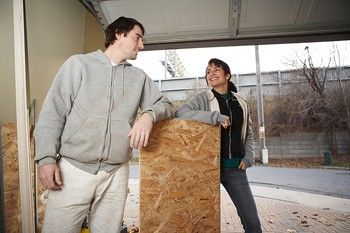
Using an entire chunk of wood, such as 0.6 inch (1.6 mm) thick sheet of wood to make furniture is not feasible and economical. Such a single sheet of wood often tends to be fragile and there is a possibility that such a sheet of wood may break or crack upon sharp shocks. Secondly, using such a piece of wood often tends be a lot costly than plywood. Thus, in order to overcome these drawbacks, plywood has come to be used in furniture making and even in construction. The strength of this man-made and constructed wood is such that it is also used in certain industrial applications. Plywood types of certain grade and strength are so strong, that they have even been used to make aircraft parts in some cases. In the following paragraphs, certain plywood sizes and types have been discussed, and a description of their anatomy and their characteristics have also been included.
What is Plywood
A plywood is made up of veneer sheets. In carpentry and woodworking, veneers are a set of thin wood slices set together with glue. The very thin slices are almost as thin as 1/8 inches (3 mm). These wood pieces are glued together in a stack, to make up a plywood. An ordinary plywood consists of about 3 such sheets of thin wood which are glued together with each veneer having its grains (seasoned wood texture), glued at right angles to adjacent layers, so as to have a better load bearing capacity. It means that two adjacent piles (layers) have adjoined grains. In order to prevent warping there are an odd number of grains in a single plywood piece. Plywood is found in several different sizes and thicknesses, depending upon the purpose it is used for. The usual thickness ranges from 0.6 inches(1.6 mm) to 3.0 inches (76 mm). 4 feet width by 8 feet height are the most common sizes for plywood. Some other lengths that are found include, 3 feet and 6 feet.
Since plywood is used for several different circumstances, there are also different grades. Here are some common plywood grades explained:
- A: Among all the plywood grades this is of the highest quality. In the A grade plywood, the front and back, outer veneers of the plywood do not have any defects.
- B: Grade B has one outer veneer which is defect free whereas the other one has a defect.
- A/BB: Here one veneer is completely defect free whereas one outer veneer is joined, i.e: is made up of further other veneers, knots and plugs.
- B: Here both outer veneers have defects.
- B/BB: Here one outer veneer has defects whereas the other one is joined up with the help of other veneers, knots and plugs.
- BB: Both outer veneers are made with other veneers, knots and plugs.
Types of Plywood and their Uses
Plywood is broadly classified into three types namely, softwood plywood, hardwood plywood and special purpose plywood. Here's some info on each type...
Softwood Plywood
The softwood plywood is prominently made from cedar, douglas fir or spruce, pine, and fir veneers. A common combination of veneers is spruce, pine and fir, known as SPF. The standard number of veneer piles that is used for softwood varies from 3, 5 and 7. Owing to greater break strength and tenacity, outdoor type of plywood is usually softwood plywood. Wood flooring, fencing, vehicle interiors, hoardings, boxes and packaging and even wind bracing panels are made with the help of softwood. Softwood is also used in making cabinets, due to its durability.
Hardwood Plywood
The hardwood plywood is classified into birch plywood and tropical plywood. A hardwood plywood is one step up from softwood. From the point of view of usability it has better break point, strength and stronger resistance against some weathering elements. This makes it an ideal candidate for heavy-duty jobs.
- Birch plywood is renowned for better break strengths, stiffness and also great resistance against external weathering. The common use of this kind of plywood is in the exterior, as it is used in blades of wind turbines and as insulation in places where Liquefied Petroleum Gas (LPG) is used. Several floors and staircases are made from birch plywood. Musical instruments, die-cutting board, parquet support and playground equipment also make use of this type of plywood.
- Tropical plywood is more common in south-east Asia. This plywood has better density and strength, which makes it warp free and better seasoned. This makes the plywood more even, and of a very high quality.
Special Purpose Plywood
Special purpose plywood is of a specified make and is used for specified purposes. Here are some examples...
- Aircraft plywood which is made from mahogany, birch and adhesives, is heat and humidity resistant. Its name is derived from its use during the second world war in the 'Mosquito' aircraft.
- Flexible plywood is a kind of plywood, which have veneers laid out in a specified form thus, giving it an apt material to make curved parts.
- In some places, plywood is exposed to some drastic weather elements, and in such circumstances it becomes necessary to use wood that has very good resistance, Marine plywood is specially treated and engineered in a way so that it sustains intense weathering.
The situation and purpose are the two principle factors which determine which type of plywood is to be used. Further more, the place where the plywood is to be used becomes the determining factor of the grade of the plywood.





